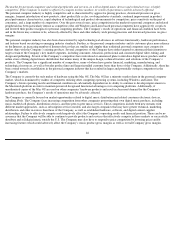Apple 2005 Annual Report Download - page 52
Download and view the complete annual report
Please find page 52 of the 2005 Apple annual report below. You can navigate through the pages in the report by either clicking on the pages listed below, or by using the keyword search tool below to find specific information within the annual report.
The Company’s future operating performance is dependent on the performance of distributors and other resellers of the Company’s products.
The Company distributes its products through wholesalers, resellers, national and regional retailers, and cataloguers, many of whom distribute
products from competing manufacturers. In addition, the Company sells many of its products and resells certain third-party products in most of
its major markets directly to end users, certain education customers, and certain resellers through its online stores around the world and its retail
stores. Many of the Company’s resellers operate on narrow product margins and have been negatively affected by weak economic conditions
over the last several years. Considerable trade receivables that are not covered by collateral or credit insurance are outstanding with the
Company’s distribution and retail channel partners. The Company’s business and financial results could be adversely affected if the financial
condition of these resellers weakens, if resellers within consumer channels were to cease distribution of the Company’s products, or if
uncertainty regarding demand for the Company’s products caused resellers to reduce their ordering and marketing of the Company’s products.
The Company has invested and will continue to invest in various programs to enhance reseller sales, including staffing selected resellers’
stores
with Company employees and contractors. These programs could require a substantial investment from the Company, while providing no
assurance of return or incremental revenue to offset this investment.
Over the past several years, an increasing proportion of the Company’s net sales has been made by the Company directly to end-users through
its online stores around the world and through its retail stores in the U.S., Canada, Japan, and the U.K. Some of the Company’s resellers have
perceived this expansion of the Company’s direct sales as conflicting with their own businesses and economic interests as distributors and
resellers of the Company’s products. Perception of such a conflict could discourage the Company’s resellers from investing additional
resources in the distribution and sale of the Company’s products or lead them to limit or cease distribution of the Company’s products. The
Company’s business and financial results could be adversely affected if expansion of its direct sales to end-users causes some or all of its
resellers to cease or limit distribution of the Company’s products.
Further information regarding risks associated with Marketing and Distribution may be found in Part I, Item 1 of this Form 10-K under the
heading “Markets and Distribution.”
The Company relies on third-party digital content, which may not be available to the Company on commercially reasonable terms or at all.
The Company contracts with third parties to offer their digital content to customers through the Company’s iTunes Music Store. The Company
pays substantial fees to obtain the rights to offer to its customers this third-party digital content. The Company’s licensing arrangements with
these third-party content providers are short-term in nature and do not guarantee the future renewal of these arrangements at commercially
reasonable terms, if at all. Certain parties in the music industry have consolidated and formed alliances, which could limit the availability and
increase the fees required to offer digital content to customers through the iTunes Music Store. Further, some third-party content providers
currently, or may in the future, offer music products and services that compete with the Company’
s music products and services, and could take
action to make it more difficult or impossible for the Company to license their digital content in the future. If the Company is unable to
continue to offer a wide variety of digital content at reasonable prices with acceptable usage rules, or continue to expand its geographic reach
outside the U.S., then sales and gross margins of the Company’s iTunes Music Store as well as related hardware and peripherals, including
iPods, may be adversely affected.
Third-party content providers and artists require that the Company provide certain digital rights management solutions and other security
mechanisms. If the requirements from content providers or artists change, then the Company may be required to further develop or license
technology to address such new rights and requirements. There is no assurance that the Company will be able to develop or license
50
























